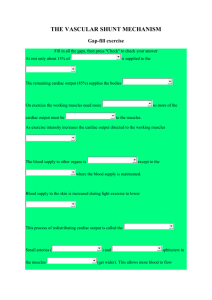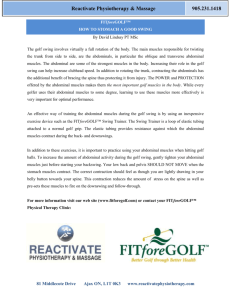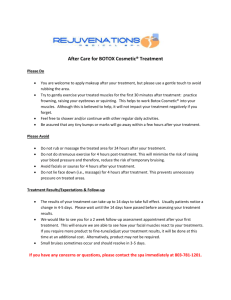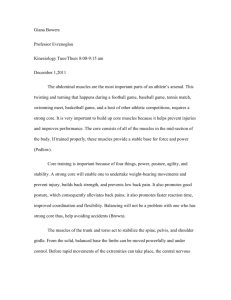ANATOMY AND PHYSIOLOGY FOR THE ASANAS
advertisement
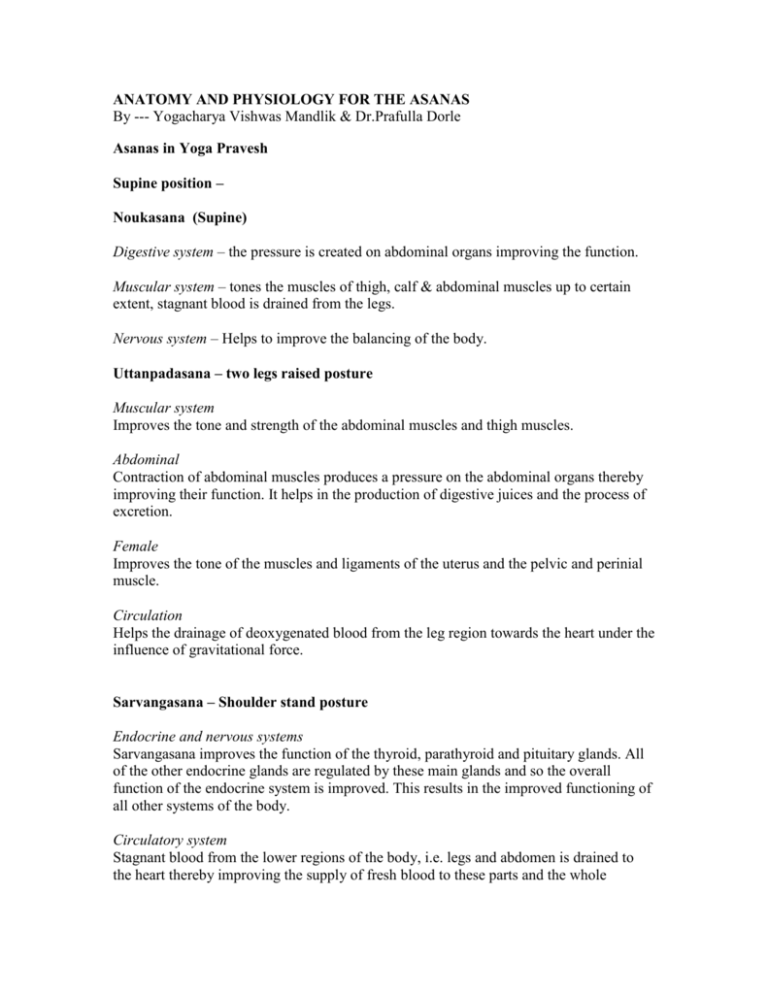
ANATOMY AND PHYSIOLOGY FOR THE ASANAS By --- Yogacharya Vishwas Mandlik & Dr.Prafulla Dorle Asanas in Yoga Pravesh Supine position – Noukasana (Supine) Digestive system – the pressure is created on abdominal organs improving the function. Muscular system – tones the muscles of thigh, calf & abdominal muscles up to certain extent, stagnant blood is drained from the legs. Nervous system – Helps to improve the balancing of the body. Uttanpadasana – two legs raised posture Muscular system Improves the tone and strength of the abdominal muscles and thigh muscles. Abdominal Contraction of abdominal muscles produces a pressure on the abdominal organs thereby improving their function. It helps in the production of digestive juices and the process of excretion. Female Improves the tone of the muscles and ligaments of the uterus and the pelvic and perinial muscle. Circulation Helps the drainage of deoxygenated blood from the leg region towards the heart under the influence of gravitational force. Sarvangasana – Shoulder stand posture Endocrine and nervous systems Sarvangasana improves the function of the thyroid, parathyroid and pituitary glands. All of the other endocrine glands are regulated by these main glands and so the overall function of the endocrine system is improved. This results in the improved functioning of all other systems of the body. Circulatory system Stagnant blood from the lower regions of the body, i.e. legs and abdomen is drained to the heart thereby improving the supply of fresh blood to these parts and the whole circulatory system. Blood supply to the head area i.e. brain, eyes, ears, nose and throat is improved thereby improving their functioning. Respiratory system The lung capacity is increased as the diaphragm, which is the muscle of respiration, has to work against gravity in this posture, this helps in the abdominal respiration and is therefore helpful in the treatment of asthma. Toxins in the respiratory system are drained thereby improving the respiratory system. Ashwini Mudra Strength of muscles of uterus, rectum, large intestine & perional region is increased. useful to prevent prolapse of uterus, rectum & preventing piles. Function of abdominal organs (especially lower abdomen) is improved. Note : It offers most of the advantages of Sarvangasana. Matsyasana Endocrine system – It causes a stretching on the thyroid gland, there by improving the function of the same. Digestive system- It stretches the intestines, liver, pancreas, bladder and other abdominal organs which results in improved functioning and efficiency. Circulatory system – Reduces blood supply to legs and redirects it to reproductive organs (pelvic organs). Stagnant blood around vertebral column is drained. Improves supply to brain and face, also puts stretch on carotid artery. Reproductive system – Due to increased blood supply the function is improved. Muscular system – Toning of abdominal & thigh muscles, intercostals muscles. Respiratory system – Toning of intercostals muscles help in deep breathing, so it is helpful in asthma & bronchitis Halasana – Digestive system – Improves the function of abdominal organs, especially the pancreas is stimulated for secretion of insulin. The breathing movements of diaphragm help to massage the abdominal organs. Muscular system – Improves the tone and strength of back muscles as the back is folded, also the leg muscles and abdominal muscles, it also removes the rigidity of the back muscles. Nervous system – Improves the working of spinal nerves, pressurizes the nerves in the neck region which are predominantly sympathetic. Endocrine system - Improves the function of the thyroid, parathyroid and pituitary glands. All of the other endocrine glands are regulated thy theses main glands and so the overall function of the endocrine system is improved. This results in the improved functioning of all the systems of the body. Asanas in Prone position – Shalabasana – Locust Posture Nervous System Stimulates the parasympathetic nerve out flow in the lower spinal region. Removes the pressure on the sciatic nerve and gives relief from back ache and slipped disc(however it should be practiced with caution for those suffering from slipped disc) Abdominal Improves the function of the abdominal organs especially the lower abdomen by improving peristalsis in the large intestine and especially in the large portion of the colon. Improves appetite Muscular System Improves the strength of thigh and abdominal muscles and improves blood supply to the lower back and neck muscles relieving stiffness in this region. Dhanurasana – Bow posture in prone position Abdominal The body weight is balanced on the abdominal muscles and they are given pressure so that the intra-abdominal organs, i.e. stomach, liver, spleen pancreas and intestines, are massaged by the change in pressure. It also improves the secretions of these organ. It improves the peristalsis of the intestine and relieves constipation. The blood flow to the abdominal organs is also improved. With regular practice it will reduce the fat around the abdomen and thigh areas. Muscular system This asana creates strength in the muscles of the spinal cord and the nerves of the back. It also strengthens the muscles of the arms and thighs. Respiratory system It widens and opens the chest area thereby improving respiration relieving asthma, bronchitis and is helpful for breast development. Circulation There is an improvement in the circulation of lymph and blood throughout the body especially the arms and legs due to the toning of the muscles. Naukasana – boat posture in prone position The effects are the same as dhanurasana but are slightly increased as the stretch and pull is not transferred to the hands and legs and so is carried by the abdominal area. Sitting position – Akarna Dhanurasana Muscular system – Toning the muscles of hands and legs especially the calf muscles, inner & back side of the thigh, & deltoid region + scapular. Improves the efficiency of the knee and elbow joint. Tones the perennial region. Circulatory system – Improves the circulation in legs due to contraction of calf muscles. Digestive system – Pressure is created on the abdomen so helps to relieve constipation & helps to improve the secretion of the glands in the abdominal region. Vakrasana Muscular system – The vertebral muscles of the back & abdomen are twisted laterally, especially the upper back 7 shoulder region is twisted. Improves the function of the spine as the blood flow to the spine is improved. Especially the cervical & thoracic spine. Tones the spinal nerves, reduces the stiffness to relieve the back ache. Helps reduce the fat in the abdominal region. Digestive system – Internal organs are twisted and so helps in draining the blood which is accumulated in the organs & the blood vassals of abdomen. Helps to drain the secretions which are remaining in the ducts of the abdominal organs. Ardha matsyendrasana Same as Vakrasana In addition to this thigh and arm muscles are toned up. Paschimottanasa Muscular system – It stretches the muscles of the back side of the body from head to the cervical region. It contracts the muscles of the anterior part of the body. This creates pressure on the thorax & abdomen, improving the process of respiration & the functions of the intra abdominal glands especially the secretions. Improves the flexibility of the lumber region, the hips & thigh ( back side of thigh & calf) Improves the blood circulation in the back region & tones up the spinal nerves. Improves alignment of the vertebral column. Removes the fat from the hips, the abdomen & thigh region. Standing Position Vrikshasana Muscular system – All muscles are working in the same direction, which helps to remove the spasm of every muscles. Helps bone development and proper alignment of the vertebral column. Veerasana Muscular system – Improves the strength & blood supply to the joints like ankle, knees, hips, lumber region & cervical region & shoulders. Abdominal muscles are stretched so helps to remove fat from the region. Nervous system - Helps to maintain the proper balance of the body. Trikonasana Muscular system – Function of hips, knee, ankle & shoulder is improved. Lateral abdominal. lateral back side of thigh & calf muscles + scapular muscles. Nervous system - Helps maintain proper balance of the body, removes fat from the waist. References – Yoga Pravesh – Yogacharya Vishwas Mandlik Asana Pranayama Mudra Bandha – Swami Satyananda Saraswati Hatha Yoga Pradipika – (commentary & translation) Swami Satyananda Saraswati
